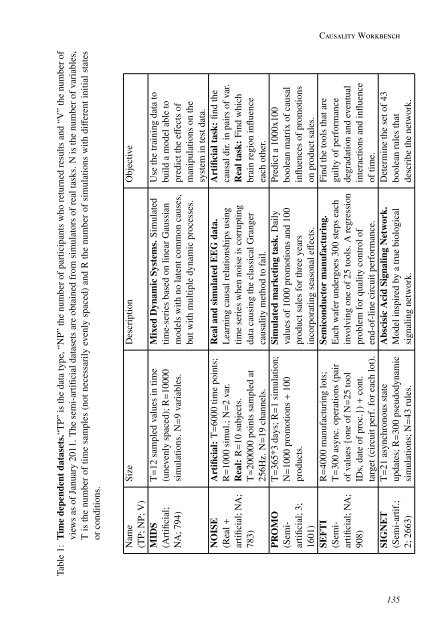Causality in Time Series - ClopiNet
Causality in Time Series - ClopiNet
Causality in Time Series - ClopiNet
Create successful ePaper yourself
Turn your PDF publications into a flip-book with our unique Google optimized e-Paper software.
<strong>Causality</strong> WorkbenchTable 1: <strong>Time</strong> dependent datasets.“TP” is the data type, “NP” the number of participants who returned results and “V” the number ofviews as of January 2011. The semi-artificial datasets are obta<strong>in</strong>ed from simulators of real tasks. N is the number of variables,T is the number of time samples (not necessarily evenly spaced) and R the number of simulations with different <strong>in</strong>itial statesor conditions.Name(TP; NP; V)MIDS(Artificial;NA; 794)NOISE(Real +artificial; NA;783)PROMO(Semiartificial;3;1601)SEFTI(Semiartificial;NA;908)SIGNET(Semi-artif.;2; 2663)Size Description ObjectiveT=12 sampled values <strong>in</strong> time(unevenly spaced); R=10000simulations. N=9 variables.Artificial: T=6000 time po<strong>in</strong>ts;R=1000 simul.; N=2 var.Real: R=10 subjects.T≃200000 po<strong>in</strong>ts sampled at256Hz. N=19 channels.T=365*3 days; R=1 simulation;N=1000 promotions + 100products.R=4000 manufactur<strong>in</strong>g lots;T=300 async. operations (pairof values {one of N=25 toolIDs, date of proc.}) + cont.target (circuit perf. for each lot).T=21 asynchronous stateupdates; R=300 pseudodynamicsimulations; N=43 rules.Mixed Dynamic Systems. Simulatedtime-series based on l<strong>in</strong>ear Gaussianmodels with no latent common causes,but with multiple dynamic processes.Real and simulated EEG data.Learn<strong>in</strong>g causal relationships us<strong>in</strong>gtime series when noise is corrupt<strong>in</strong>gdata caus<strong>in</strong>g the classical Grangercausality method to fail.Simulated market<strong>in</strong>g task. Dailyvalues of 1000 promotions and 100product sales for three years<strong>in</strong>corporat<strong>in</strong>g seasonal effects.Semiconductor manufactur<strong>in</strong>g.Each wafer undergoes 300 steps each<strong>in</strong>volv<strong>in</strong>g one of 25 tools. A regressionproblem for quality control ofend-of-l<strong>in</strong>e circuit performance.Abscisic Acid Signal<strong>in</strong>g Network.Model <strong>in</strong>spired by a true biologicalsignal<strong>in</strong>g network.Use the tra<strong>in</strong><strong>in</strong>g data tobuild a model able topredict the effects ofmanipulations on thesystem <strong>in</strong> test data.Artificial task: f<strong>in</strong>d thecausal dir. <strong>in</strong> pairs of var.Real task: F<strong>in</strong>d whichbra<strong>in</strong> region <strong>in</strong>fluenceeach other.Predict a 1000x100boolean matrix of causal<strong>in</strong>fluences of promotionson product sales.F<strong>in</strong>d the tools that areguilty of performancedegradation and eventual<strong>in</strong>teractions and <strong>in</strong>fluenceof time.Determ<strong>in</strong>e the set of 43boolean rules thatdescribe the network.135





